There are not many marine preserves in Greece – in fact, not many in the entire the Med – but we set our course for the island of Arki, a soon-to-be ratified part of the North Dodecanese Wildlife Refuge, and a short distance from Leros where we had started from just a week ago. I wasn’t sure what to expect from a protected area in Greece, but our arrival in the calm harbor of Port Augusta answered any doubts I had. Here was an only slightly larger version of the charming little village of Agathonisi that we had visited last week. Approaching the small town quay, we could see plenty of space around the few boats already med moored to the quay. After the warmup at Agathonisi, Karen was in natural form as she turned Sea Rose around and began backing into the quay as I lowered the anchor. Med mooring with two people is a bit tricky, as you can really use a third person to manage tying the stern lines to the quay. Thankfully, a gentleman from a nearby boat wandered over and helped with that task. And the reduced breeze reduced the stress level as well.
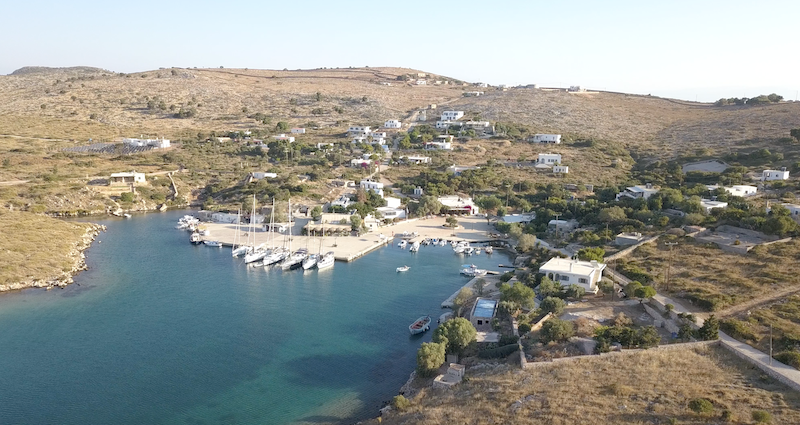
With the lines and anchor tight and secure, we took in our new surroundings. A taverna, shaded by a thatched roof patio and umbrellas, was a prominent eye-catcher. Other boaters seemed content to relax in the shade of their cockpits with a no-rush, no-fuss state of mind. Like so often before, Karen and I will leave an anchorage in the morning and arrive at our destination in the middle of the afternoon, the ‘dead’ hour when the sun’s heat hits its peak and people take shelter from it’s energy-sucking powers. The concept of a siesta was not new to us – this was the start of our third summer of sailing here – but it always takes a hardy change of mindset when we arrive back in the Med. The temptation as visitors is to head ashore as soon as one arrives to explore our new surroundings. But doing this, you will inevitably be disappointed. Shops will be closed, the heat will kill your energy for the rest of the day, and absent of locals, the streets will lose their vibe, leading one to think you were dropped into a ghost town.
Karen and I helped two other arriving boats tie off their lines, and after exchanging pleasantries, jumped in the water to cool off, in our version of the siesta culture. I was a little reluctant at first, as harbors, even ones in tiny villages, can be less than clean, and dare I say, less than sanitary. But here the visibility was clear to the sea floor, fish darted amongst the weeds and rocks, and life was good.
Life was even better in the early evening, as the heat of the day subsided and the gradual reawakening occurred on shore. It truly feels like two separate days, with people magically re-emerging as if they suddenly unwrapped their Harry Potter style invisibility cloaks. We found the town square just a few steps off the quay, and here were two more tavernas for the picking, demanding your attention with their vibrant colors. We selected Taverna Nicholas, on the advice of a neighboring boater, and to our surprise, this taverna was famous for not only delicious meals, but a large collection of model boats. Several years ago, the restaurateur’s father made a model of a greek fishing boat for his grandson. Soon more followed. Then patrons would arrive the next season and bring more. Today, there are enough to fill a shallow lagoon next to the restaurant, and plenty of extras to hang from the ceiling. I can only hope some day that both my talent, and my grand child’s interest, will warrant such a model making endeavor!

On our walk outside the village in the morning, it wasn’t hard to figure out the source for last night’s tasty goat stew. Like sheep outnumbering humans in New Zealand, there were easily more goats on this island than people. If you gave them the right to vote, it could seriously change the course of history here!
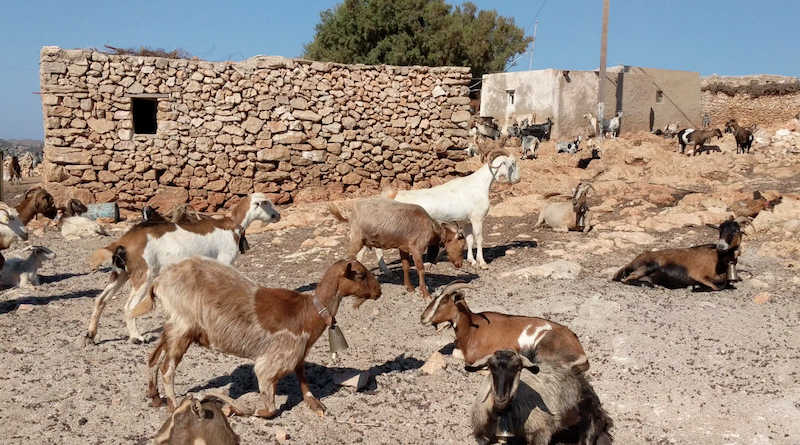
Our destination for the day was Patmos, a mere 8 miles to the west. Checking the forecast beforehand, we needed to prepare for gusty winds, and I saw this as an opportunity to try our new storm jib. We had bought the boat with an optional removable inner forestay, designed to carry a small jib for high winds, but it wasn’t until the first winter that we had the sail built, by our good friend Luigi in Gaeta, Italy. Then, we got busy last summer and never seemed to have a free chance to try it out. Well, today was the day. We tightened up the forestay and hanked on the sail while motoring out of the Arki harbor. Soon enough, it was blowing 20 knots on the beam, and the storm jib, along with one reef in the mainsail, was enough to scoot Sea Rose along at a respectable pace. Once we were free of the shores of Arki, the wind hit a steady 25 knots, and I was very thankful for the storm jib. We could achieve the same small sail area by putting three reefs in the genoa, but that sail loses shape quickly. This was a far superior arrangement.
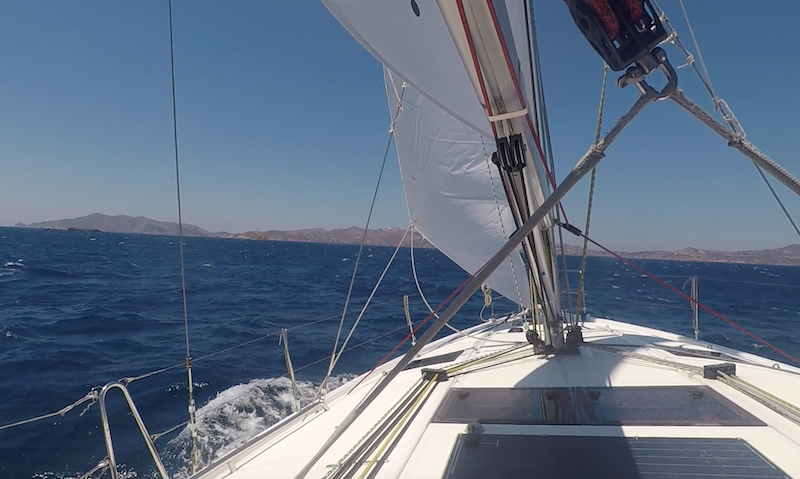
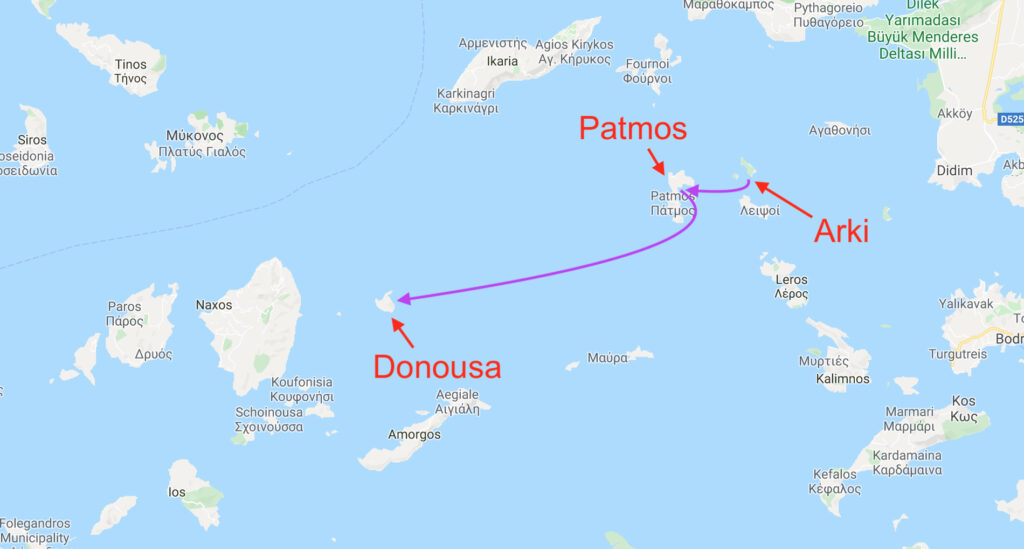
As we arrived in the expansive eastern bay of Patmos, the wind only increased in intensity. This was odd and made me wonder if the prevailing Meltemi winds combined with the height of these islands, causes some kind of compression as you approach land, causing the wind to accelerate, like it does on the upper surface of an airplane wing. With a steady 30 knots, and our chosen anchorage of Patmos Kambos just upwind of us, it was time to douse the sails and motor the remaining distance.
In the morning, we decide to move venues, two miles down the bay and closer to the main town of Scala. We found a fine anchorage just around the corner from the town, within reach by dinghy, and we wasted no time securing the boat and going ashore. Despite white caps visible offshore, there was strangely not a breathe of wind onshore.
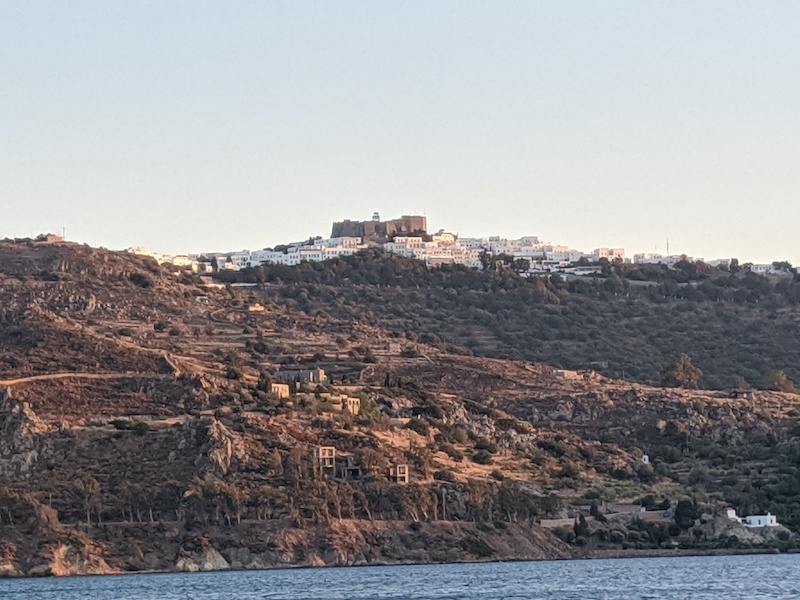
The main attraction here is the Chora (main town) at the top of the hill, with its imposing fortification and monastery. We set out by foot along the busy road to the top, as I wondered why we didn’t just opt for a scooter or ATV rental as swarms of both pass us and leave behind their two stroke engine exhaust. The cruising guide described the hike to the top as a 20 minute affair, but I withheld from Karen the fact that Google maps was telling me we are in for 45 minutes. Like a loaf of bread being baked in a stone oven, the searing heat, hitting us once directly and twice reflected off the stone path made me long for a blustery winter day on top of any peak at Sunday River. Interim relief came in the form of St John. Well it was the Cave of the Apocalypse to be specific. At this very spot, halfway up to the Chora and many years before, there is a claim that St John lived in the cave here and received a message from God that was recorded as the biblical Book of Revelations. I think they lost money on the amount I drained their water cooler versus the 3 euro entry fee.
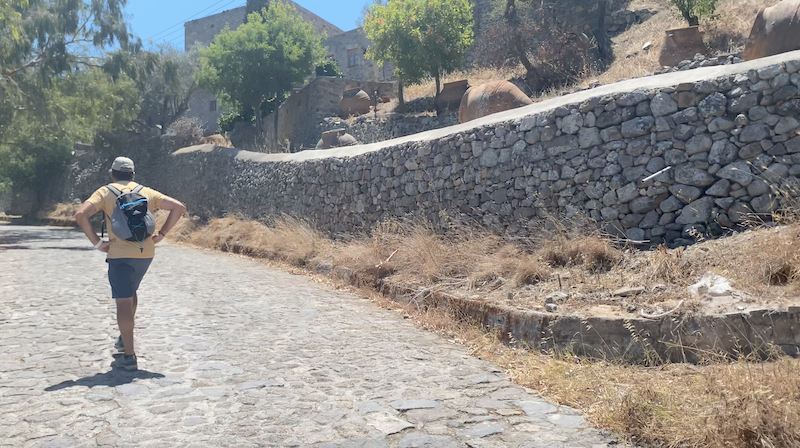
Refreshed and inspired, Karen and I continued our hike and soon were in the narrow alleyways that in days of yore were meant to confuse intruders, but were no match for our keen focus on finding a taverna to rest our weary legs and guzzle any make and model of cold beverage. The fine views from the taverna terrace, as we gazed far down to Sea Rose swinging on her anchor below, caused us to linger too long over inexpensive house wine, and alas, as we walked the additional steps to the monastery entrance, changing first into more conservative clothing, we were disappointed to find that it closed at 2pm! Stung by the siesta again!
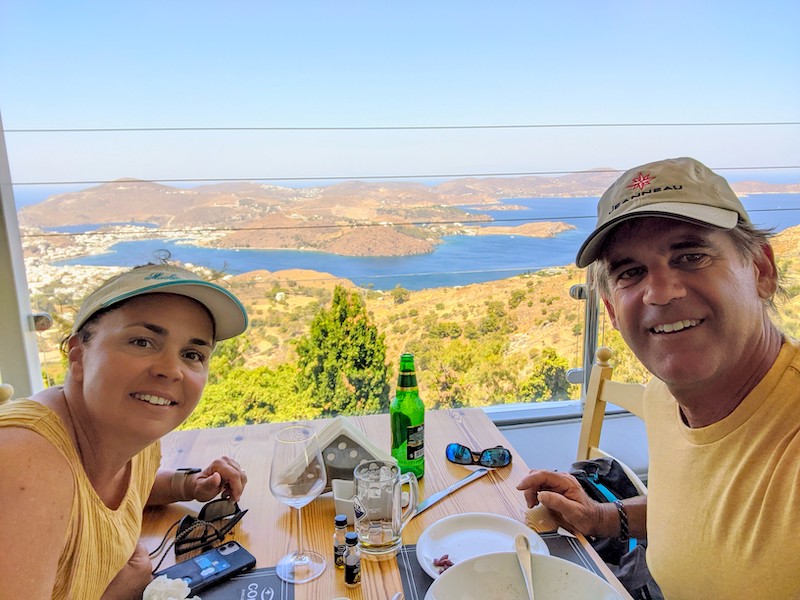
Descending the hill was much easier, and as the evening approached, we made a list of errands to do ashore, giving us an excuse to experience the Scala re-awakening. Sailing is not all sunscreen and umbrella drinks. On today’s shopping list was dinghy gas (necessitating an overland walk with the gas jug to a service station), a stop at the marine store for a head (toilet) pump assembly (at 100 euros, a steal to me, and by the look on the merchant’s face, a lucrative sale), and a few GoPro parts. Thankfully the Greek way of life is such that one merchant will happily point you in the direction of the store with the next item on your list. For our last stop, a cocktail in the local town square (technically, neither of us had a drink with an umbrella in it…) gave us another glimpse into the Greek post-siesta scene. The gist of it was this – women dressed to the nines, guys dressed down, and stylish pre-teen girls walked repeated loops around the square – too young to have a cocktail, too old to be hanging out at home with mom and dad. So, really not that different than most anywhere else!
With two days under our belts in Patmos, it was time to start our march westward. Our next leg, 40 miles to the small island of Donousa, would be our first long day passage of the summer. The short island hops in the Dodecanese were over and to be frank, I was a bit anxious. I knew we would get into the groove soon, but taking a break and returning to something that was before so natural can be stressful. Those first few runs of the ski season, the first time pitching a tent and stoking a campfire, the first day of classes after a busy summer break, a promising dinner after a dating hiatus. You’ve done it before, but that doesn’t make it any easier.
As we rounded the southern tip of Patmos just after sunrise, the wind started to freshen right on cue. Soon we were reefing sails to match the 25 knots of wind. We found our layline and settled into a close reach course. As we cleared the coast of Patmos, the winds eased to 17 knots, giving me more reason to be believe a theory of wind compression around these islands.
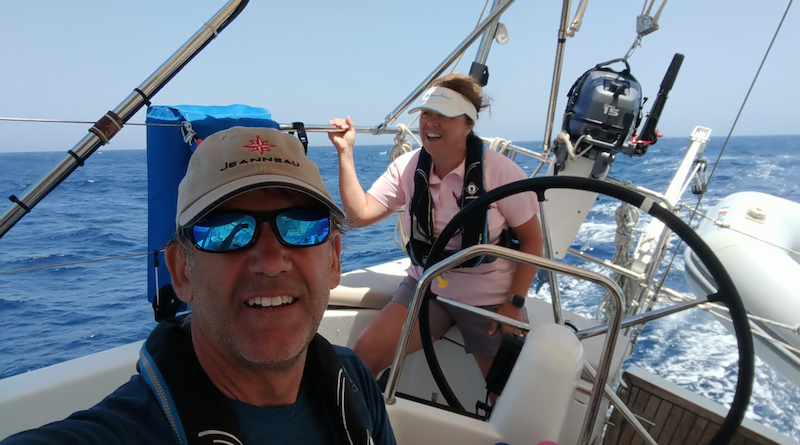
As we entered the middle of our passage, the waves became steeper and the wind shifted to cause us to sail close-hauled and with it, more crashing into oncoming waves. In the distance I could see a high cloud on the horizon that was not moving. I wondering if this could be marking the peak of Donousa, reported to be a tall island. With the increased sea state, both of us wanted to get this roller coaster over with and arrive at our destination.
Sure enough, as we got closer, the cloud I had been seeing earlier was ‘stuck’ on Donousa’s peak, likely forming from the high winds, and dissipating on the down slope. Reminding me of the tall, skinny peak of Saba in the Caribbean, we approached the harbor, quickly dousing our sails and setting our trusty anchor in nice soft, grippy sand. Our first long passage was over and we could settle in the cockpit for a late lunch and an attractive view of steep cliffs descending rapidly to the sea, that is before both of us gave into the temptation of an afternoon nap!
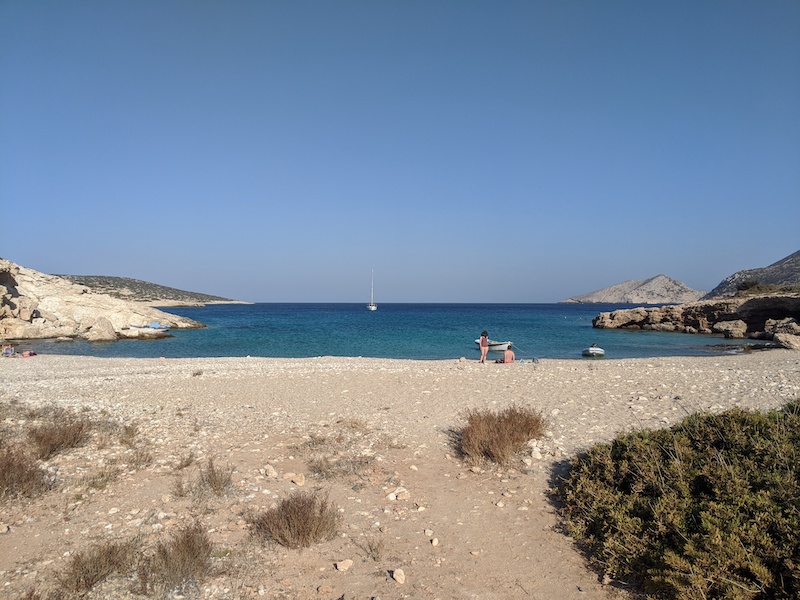
Before nightfall, we dinghied ashore to find a lively, nearly-full taverna with a terrace overlooking the small cove. It was only 7pm, prime time for dinner at home but not here in the EU. Regardless, the enticing aromas as we passed downwind of the kitchen were an international signal that needed no translation. We joined the crowd for a light dinner, more house wine, and a chance to eavesdrop on the words and lives of our fellow travelers. Moments after our salads arrived, the kitchen fan was shut down and Grama settled in amongst the patrons to peel potatoes for tomorrow’s next cast of hungry customers.

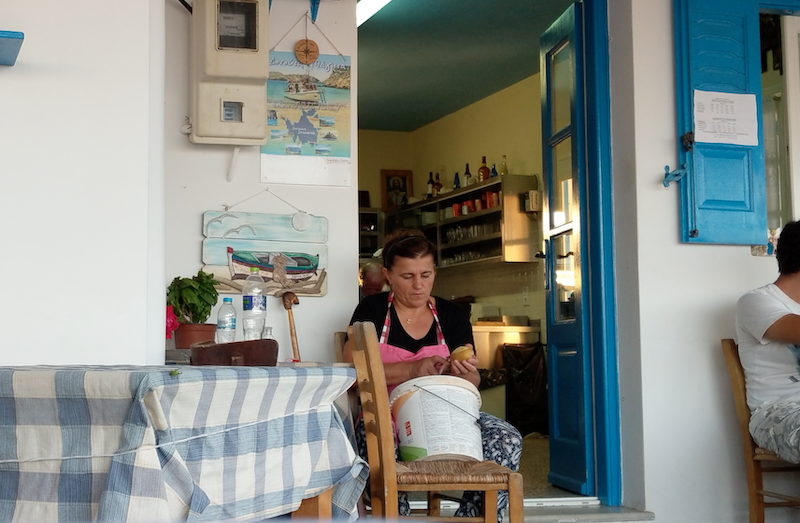
And that would have marked the quiet end to a typically simple Greek dinner, overlooking the sparkling waters of the Mediterranean, had it not been for the fitful screams of a teenage girl walking briskly up the road from the beach. I had seen her before, walking hand-in-hand with what must have been her baby sister, and left me with pleasing thoughts of sibling love. But this was something different entirely. This teen was angry, spewing a long list of hostile words that, judging from the reaction of the Greek speaking taverna patrons, couldn’t be farther from the language of love. With our waiter as translator, we learned that the source of the angst was the seemingly innocuous case of a lost flip flop. I’m not a linguist, but my teen-translating and emotional radar skills have had some practice. My assessment was this. Hey, Mom and Dad, I’ve been watching little sis all day in the hot sun while you guys have been relaxing. Now, as soon as I turned around, she threw my favorite flips flops in the whole world into the ocean and now I hate her, she’s the worst sister ever, and I don’t want to be here, and get me off this f***ing island now!
I offered to the Mom, who was pacing the beach looking for the lost flip flop, that I could go out in my dinghy to search downwind. She and her recalcitrant daughter came along. For a moment, I thought I had accidentally acquired some family counseling skills, as I refocussed the daughter from her temper tantrum, sand-throwing outbursts, to one of being part of the solution. Like an aerial search party, we agreed on who was to look in what direction. But try as we might, and working against the fading light, we did not find said lost flip flop. Back onshore, the daughter wouldn’t make eye contact, despite the prodding of her mother to thank me. I re-joined Karen at the taverna for a last sip of wine, as the teen kept her distance from the patrons. I would like to think she was embarrassed about her earlier so visible out burst, and was feeling remorseful. I would take the roller coaster of 30 knots and close-hauled seas than the ups and downs of an emotional teenager, any day!
At dusk, returning by dinghy to Sea Rose, Karen and I took another long sweep of the harbor and rocky shoreline. As we gave up and headed back to the boat, I could see the headlights of a car at the water’s edge, waiting, then pulling away as we tied off the dinghy.
We will start on another long leg across to the island of Naxos tomorrow, officially leaving the Dodecanese and returning to the Cyclades, familiar as they were from our explorations last summer as they were 28 years ago during our honeymoon.
Until then, it’s time for a hard-earned siesta-style nap!

